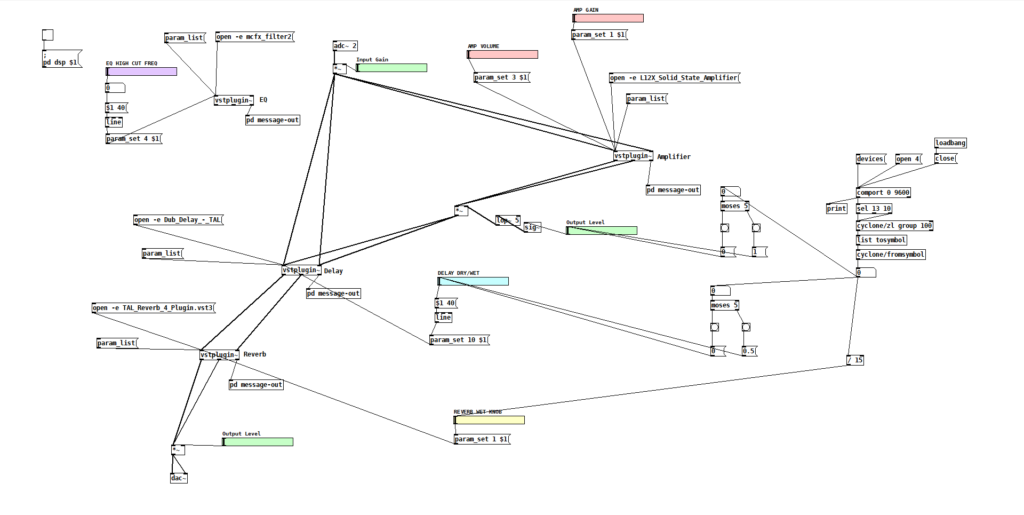With a new means of communication in place (compare blog #12), a new Pure Data patch was made. After having created custom effects (the delay and the overdrive/distortion effect) for the first Pure Data patch, it was now deemed better to use third-party effect plugins. Luckily, with the help of the object “vstplugin~”, such third-party plugins can be used inside of Pure Data. Furthermore, it is possible to access the plugins’ list of parameters and control them by sending control messages.
The Pure Data patch uses the following three plugins:
- L12X Solid State Amplifier
- TAL Dub Delay
- TAL Reverb 4
The plugins were chosen due to personal constraints: the author is primarily using a desktop PC for audio-related tasks and, hence, most plugins are only available to the author on the desktop PC. As the author’s laptop is used for this project, free plugins were chosen.
At first, a prototype setting for the solo mode was made. Here, the parameter mapping is as follows:
The values coming in from the Arduino are the fret numbers that were calculated from the distance to the ToF sensor in the Arduino sketch. The incoming fret number determines if the amplifier plugin is turned on or off. Using a “moses” object set to the threshold of five, the incoming fret number is compared to the number five. If the fret is below five, the amplifier is or stays turned off. If the fret number is above five, it is turned on. Additionally, fret numbers above five increase the delay’s and the reverb’s wet parameters. As a result, one has a rhythm tone using reduced effect settings when playing below the fifth fret and a more overdriven and effect-laden, lead tone when reaching for frets five and above. The threshold of five is, of course, variable. It was chosen in this case because when playing in A one can easily begin to play a solo at the fifth fret position and above. The test was successful with the rhythm/lead tone switching happening quite reliably and sufficiently fast.
Next, instead of using fixed settings that were being switched either on or off, it was tried to control certain effect parameter settings more fluidly according to the fret number. For instance, the reverb wet knob was set to increase in value as the fret number increases. Consequently, a note played on the first fret had much less reverb than a note played at the 12th fret with the values in between increasing at a steady rate.
With the steady communication between Arduino and Pure Data working, a whole lot of new tonal possibilities was opened, and I am sure that there are a lot more possibilities to discover as far as mapping certain effect parameters to the Arduino data is concerned. This, however, will most probably take place in the third semester during the third phase of the project where suitable effects and playing styles that exploit the two setups’ capabilities will be further explored.
